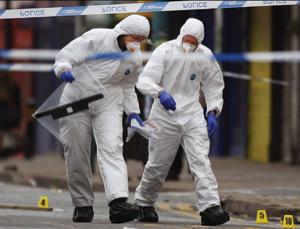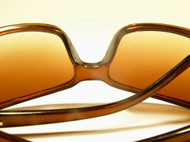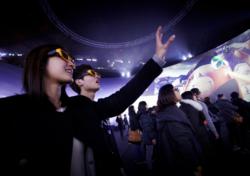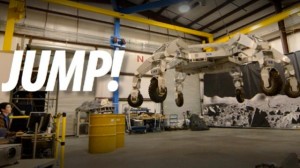Top 10 Technologies That Revolutionized The Way We Watch Movies
 The Hand-Held Camera – And we’re off! In the 1890s, Auguste and Louis Lumière developed the Cinematograph, which could be mounted on a tripod or carried by a cameraman. Shaky-cam, here we come!
The Hand-Held Camera – And we’re off! In the 1890s, Auguste and Louis Lumière developed the Cinematograph, which could be mounted on a tripod or carried by a cameraman. Shaky-cam, here we come!
Rotoscoping -
The Optical Printer –
Sync Sound –
Color –
The Steadicam –
Video –
Digital Video –
3D – 3D films first arrived in the 1950s, but were largely regarded as a niche in the movie industry for decades before experiencing a full-blown cultural breakthrough in the 2000s, culminating in the unforeseen success of James Cameron’s Avatar. Nowadays, nearly every blockbuster is released in 3D or IMAX. Sometimes both!
Computers –
Read the full story here:
The Robot That Can Leap Over Asteroids
The world’s most amazing athlete works for NASA. Meet the gigantic, six-legged, tool-wielding robot that can hop around an asteroid. Tiger Woods ain’t got nothin’.
The robot you see in the video is a half-scale model of a vehicle that NASA wants to send on a human mission to the moon. Half. This thing is 4m tall. It’s naked in the video, but when it eventually launches, it’ll have a payload on its back. It’ll probably house a ton of tools and gear, and even temporary space for a crew of one or two. It’s the lunar rover’s mutant, roboinsectoid big brother, and it’s incredible. ...
Oh, and it does all of this in 3D. ATHLETE is a super-spider (with six legs, I know. Maybe it was in a fight?). Not only does it have tons of eyes, but the eyes all come in pairs, enabling perhaps the only useful implementation of 3D ever. The drive cameras, hazard avoidance cameras (haz-cams), and tool cams are all stereoscopic. When you’re navigating a foreign world, two dimensions aren’t going to cut it. You need depth-perception. You need to see the world as if you were standing there. ...
Read the full story here:
AR goggles make crime scene investigation a desk job
 CRIME scene investigators could one day help solve murders without leaving the office. A pair of augmented reality glasses could allow local police to virtually tag objects in a crime scene, and build a clean record of the scene in 3D video before evidence is removed for processing.
CRIME scene investigators could one day help solve murders without leaving the office. A pair of augmented reality glasses could allow local police to virtually tag objects in a crime scene, and build a clean record of the scene in 3D video before evidence is removed for processing.
The system, being developed by Oytun Akman and colleagues at the Delft University of Technology in the Netherlands, consists of a head-mounted display receiving 3D video from a pair of attached cameras controlled by a laptop carried in a backpack. This arrangement lets the wearer see their surroundings as normal while also allowing them to overlay virtual objects, which are placed using hand gestures.
A menu appears to float over the left hand when the wearer holds it in front of them. Moving the left hand back and forth selects from a variety of tools, while the right hand serves as a pointer to tag objects in the scene, like blood spatter or bullet holes. The system stores the markers as part of a 3D model of the scene, which investigators can use to help their investigation. It may also be admissible in court as evidence.
If the person wearing the glasses requires assistance, they can contact someone back in the lab who can watch their video stream, speak to the wearer through a headset and place markers in the scene using a mouse and keyboard. This would also allow a police officer to take the first look around a crime scene.
...
Read the full article here:
Apple bring 3D into the real world
 The world of 3D is branching out from movies and television into our everyday lives. Apple have just released the i-Glass - a pair of regular looking spectacles, which allow the wearer to experience real life in 3 dimensions.
The world of 3D is branching out from movies and television into our everyday lives. Apple have just released the i-Glass - a pair of regular looking spectacles, which allow the wearer to experience real life in 3 dimensions.
Users will now feel like they are immersed in their own world and enjoy the amazing sense of perspective; making them feel like they are surrounded by actual objects which are different distances away from them.
Read the full story here.
House built out of Euros
This is a surprisingly beautiful artistic expression of the chaos inflicted on individuals by the global economic situation.
New Perspectives On Old Perspectives: How An Art Project Helped The NYPL Put Its 3D Stereograph Collection In Your Hands
 The New York Public Library has released a new website called The Stereogranimator, which allows patrons to create their own animated files or 3-D images from the Library's collection of stereographs, a popular 19th Century photo format. The web project gives this important, historic medium new life, and also highlights the work of NYPL patron Joshua Heineman, who started creating his own moving images from Library stereograms as an art project for his blog. The Library's NYPL Labs team was so impressed it decided to build on his idea. Here's his story about how the idea took shape and grew into a Library project.
The New York Public Library has released a new website called The Stereogranimator, which allows patrons to create their own animated files or 3-D images from the Library's collection of stereographs, a popular 19th Century photo format. The web project gives this important, historic medium new life, and also highlights the work of NYPL patron Joshua Heineman, who started creating his own moving images from Library stereograms as an art project for his blog. The Library's NYPL Labs team was so impressed it decided to build on his idea. Here's his story about how the idea took shape and grew into a Library project.
....
Read the full story here:
‘Live Park,’ World’s First 4D Avatar Theme Park, Success in Korea
 ‘Live Park’ is composed of 65 attractions over 7 thematic stages and uses state of the art 3D video, holograms and augmented reality technology to create a seamless story. The park can accommodate up to 3,000 visitors at any one time or 10,000 visitors a day.
‘Live Park’ is composed of 65 attractions over 7 thematic stages and uses state of the art 3D video, holograms and augmented reality technology to create a seamless story. The park can accommodate up to 3,000 visitors at any one time or 10,000 visitors a day.
Read the original post here:
Augmented Reality Thundercats? Yes please,
"...it makes perfect sense as a tool for kids and parents alike to preview their purchases online before handing over their cash." That's marketing spin for watch a commercial at point of sale. Still, it is a useful idea.
See the story and watch the video here.
Printing a Home: The Case for Contour Crafting
Khoshnevis calls his technique “Contour Crafting” and it operates on roughly the same principle as consumer 3D printers like MakerBot’s Thing-O-Matic. His robot pours out a trail of viscous concrete while tracing along the footprint of a wall. As the nozzle sweeps back and forth, the layers rapidly build, with the lower ones hardening enough to support the increasing weight. Its speed puts construction workers to shame.
Read the full story here.
The Guiding Light (Holography and moving microscopic matter)
... Manipulation of micrometer scale objects in three dimensions is possible because gradients in the intensity, phase and polarization of computer-generated holograms give rise to forces that can trap and move microscopic matter. These holographic optical tweezers are useful for assembling photonic devices to the possibility of true tractor beams that pull objects back to their source. Holographic optical trapping provides unprecedented control over the microscopic world. Holographic micromanipulation is complemented by holographic video microscopy, which creates volumetric images of three-dimensional systems in real time. ...
See the full post here:
Pages
- About Philip Lelyveld
- Mark and Addie Lelyveld Biographies
- Presentations and articles
- Tufts Alumni Bio
